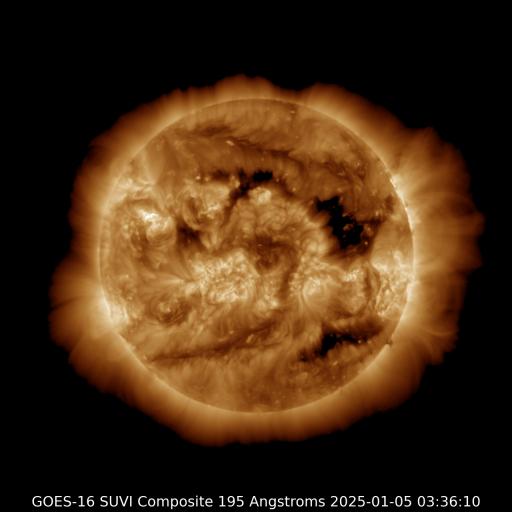Viewing archive of Friday, 23 April 2010
Solar activity report
Any mentioned solar flare in this report has a scaling factor applied by the Space Weather Prediction Center (SWPC). Because of the SWPC scaling factor, solar flares are reported as 42% smaller than for the science quality data. The scaling factor has been removed from our archived solar flare data to reflect the true physical units.
Report of Solar-Geophysical Activity 2010 Apr 23 2201 UTCPrepared by the NOAA © SWPC and processed by SpaceWeatherLive.com
Joint USAF/NOAA Report of Solar and Geophysical Activity
SDF Number 113 Issued at 2200Z on 23 Apr 2010IA. Analysis of Solar Active Regions and Activity from 22-2100Z to 23-2100Z
Solar activity was very low. No flares were observed
and the visible disk remained spotless. A CME was visible in both
Stereo A and B coronagraphs leaving the sun around 22/00Z with
trajectories suggesting a potentially geoeffective event. SOHO
LASCO data gaps in C2 and C3 imagery prohibit confirmation of a halo at this time.
IB. Solar Activity Forecast
Solar activity is expected to remain
very low for the next 3 days (24-26 April).
IIA. Geophysical Activity Summary 22-2100Z to 23-2100Z
The geomagnetic field was mostly quiet to unsettled, with the
exception of a brief period of minor storming and active conditions
between 00-06Z. This activity was due to elevated solar wind speeds
from a coronal hole and a brief switch to negative polarity.
IIB. Geophysical Activity Forecast
The geomagnetic field is
expected to be quiet for the next 3 days (24-26 April).
III. Event Probabilities 24 Apr to 26 Apr
| Class M | 01% | 01% | 01% |
| Class X | 01% | 01% | 01% |
| Proton | 01% | 01% | 01% |
| PCAF | Green | ||
IV. Penticton 10.7 cm Flux
Observed 23 Apr 075 Predicted 24 Apr-26 Apr 075/075/080 90 Day Mean 23 Apr 081
V. Geomagnetic A Indices
Observed Afr/Ap 22 Apr 004/006 Estimated Afr/Ap 23 Apr 012/014 Predicted Afr/Ap 24 Apr-26 Apr 005/008-005/005-005/005
VI. Geomagnetic Activity Probabilities 24 Apr to 26 Apr
| A. Middle Latitudes | |||
|---|---|---|---|
| Active | 10% | 10% | 10% |
| Minor storm | 05% | 05% | 05% |
| Major-severe storm | 01% | 01% | 01% |
| B. High Latitudes | |||
|---|---|---|---|
| Active | 15% | 15% | 15% |
| Minor storm | 10% | 10% | 10% |
| Major-severe storm | 01% | 01% | 01% |
All times in UTC
Current data suggests there is a slight possibility for aurora to appear at the following high latitude regions in the near future
Norilsk, VorkutaLatest news
Latest forum messages
Incoming & Unnumbered Active Regions 1677AR4048 126New satellites - Proba-3, PUNCH, SWFO-L1, GOES-U/19 47AR 4054 21Unspecified geomagnetic activity 2229
More topicsSupport SpaceWeatherLive.com!
A lot of people come to SpaceWeatherLive to follow the Sun's activity or if there is aurora to be seen, but with more traffic comes higher server costs. Consider a donation if you enjoy SpaceWeatherLive so we can keep the website online!

Latest alerts
15:15 UTC - Geomagnetic activity
Minor G1 geomagnetic storm (Kp5) Threshold Reached: 14:59 UTC
06:30 UTC - Type II Radio Emission
Begin Time: 08/04/2025 05:53 UTC Estimated Velocity: 456km/sec.
05:15 UTC - Hemispheric Power Index
The OVATION model predicts the Hemispheric Power Index to reach 50GW at 06:02 UTC
00:55 UTC - Coronal hole
A southern hemisphere coronal hole is facing Earth. Enhanced solar wind could arrive in ~3 days
Monday, 7 April 2025
20:45 UTC - Geomagnetic activity
Active geomagnetic conditions (Kp4) Threshold Reached: 20:39 UTC
Space weather facts
| Last X-flare | 2025/03/28 | X1.1 |
| Last M-flare | 2025/04/05 | M1.0 |
| Last geomagnetic storm | 2025/04/06 | Kp5 (G1) |
| Spotless days | |
|---|---|
| Last spotless day | 2022/06/08 |
| Monthly mean Sunspot Number | |
|---|---|
| March 2025 | 134.2 -20.4 |
| April 2025 | 151.3 +17.1 |
| Last 30 days | 135.2 -4.5 |





